From Decline to Revival: The Role of Organizational Archetypes in Shaping Company Success
- Mzukisi Qunta
- Nov 18, 2024
- 5 min read
Updated: Nov 18, 2024

In the dynamic world of organizational growth, companies must navigate various phases of development, as described in the Organizational Life Cycle Theory and Greiner’s Growth Model. While these frameworks provide valuable insights into the evolution of organizations, they leave one critical question unanswered: What fundamental structures and cultural models shape an organization’s ability to succeed—or recover from decline?
This question brings us to the concept of organizational archetypes, which serve as the DNA of how companies function, adapt, and innovate. By understanding these archetypes and knowing when to shift from one to another, organizations can not only prevent stagnation but also unlock new avenues of growth.


In this follow-up to “Transitioning from Generalist to Specialist in Company Growth,” we’ll delve deeper into archetypes, their origins, and how their transformation has influenced the trajectory of companies in the engineering consultancy, construction, and Scan to BIM industries.
Archetypes: The Foundations of Organizational Structure
Organizational archetypes are deeply rooted models that describe the structures, processes, and cultures of companies. First conceptualized by Henry Mintzberg in The Structuring of Organizations (1979), archetypes provide a framework for understanding how businesses are organized to achieve specific goals.
While Mintzberg introduced archetypes such as Machine Bureaucracy, Professional Bureaucracy, and Adhocracy, later theorists like Charles Handy expanded on the concept, integrating cultural dynamics into archetype theory (Handy, 1993). These models help explain why certain organizations thrive in specific industries or environments and why others falter when external or internal conditions shift.
Key Origins of Organizational Archetypes
Mintzberg’s Configurations
Mintzberg identified several structural configurations, including:
- Simple Structure: Small, informal, and centralized, typical of start-ups.
- Machine Bureaucracy: Highly formalized and hierarchical, suited to large-scale, stable industries.
- Adhocracy: Flexible, innovative, and decentralized, ideal for industries requiring constant evolution.

Charles Handy’s Archetypes
Handy’s work emphasized culture, introducing models such as:
- The Power Culture: Centralized authority, often found in entrepreneurial organizations.
- The Task Culture: Team-based, focused on collaboration and problem-solving.
- The Role Culture: Bureaucratic and rule-driven, emphasizing defined roles and responsibilities.

Why Archetypes Matter
Each archetype serves a purpose depending on an organization’s size, industry, and maturity. However, as companies evolve, their archetype may no longer align with their objectives or market environment, leading to decline.
For example, a company operating under a Machine Bureaucracy Archetype may struggle in a fast-paced, innovation-driven industry. Conversely, a start-up thriving with a Simple Structure might find it difficult to scale without adopting more formalized processes.
Archetypes in Engineering, Construction, and Scan to BIM
The engineering consultancy, construction, and Scan to BIM industries provide compelling examples of archetypes in action.
The Machine Archetype in Construction
The Machine Archetype is synonymous with traditional construction firms, characterized by rigid hierarchies, standardized processes, and a focus on efficiency.
Example: Skanska, one of the world’s largest construction companies, exemplified the Machine Archetype during its early growth. By prioritizing process optimization and centralized decision-making, Skanska efficiently managed large-scale projects across multiple markets.
Challenge: As the industry shifted toward sustainable construction and digitalization, Skanska’s rigid structure began to limit its ability to innovate.
Transition to Adhocracy
To address these challenges, Skanska incorporated Adhocracy Archetype elements, emphasizing innovation through Building Information Modeling (BIM) and sustainable design practices. By creating cross-functional teams and investing in digital tools, Skanska balanced the efficiency of a Machine Archetype with the adaptability of Adhocracy.
The Professional Bureaucracy in Engineering Consultancy
Engineering consultancy firms often thrive under the Professional Bureaucracy Archetype, where expertise and autonomy drive success.
Example: AECOM, a global engineering consultancy, operates under this archetype, enabling it to manage complex projects across diverse sectors. By empowering specialists to make decisions, AECOM ensures high-quality outcomes.
Challenge: As markets demanded faster, more innovative solutions, AECOM faced pressure to adopt more flexible structures.
Blending Professional Bureaucracy with Adhocracy
To remain competitive, AECOM integrated Adhocracy Archetype principles, such as agile project management and digital innovation. This allowed the firm to balance professional autonomy with the agility needed to respond to market changes.
3. Adhocracy in Scan to BIM
The Scan to BIM industry, which relies heavily on technological innovation, often adopts the Adhocracy Archetype. This archetype fosters a culture of experimentation and collaboration, essential for staying ahead in a rapidly evolving field.
Example: Trimble began as a technology-focused firm under the Entrepreneurial Archetype, with a flat hierarchy and emphasis on innovation. As the company scaled, it transitioned to a blend of Professional Bureaucracy and Adhocracy, leveraging both expertise and adaptability.
Challenge: Scaling without losing its innovative edge required significant cultural and structural shifts.
Sustaining Innovation
Trimble’s success lies in maintaining its innovation-driven culture while formalizing processes to support global operations. By investing in research and development and fostering cross-disciplinary collaboration, Trimble exemplifies how to sustain an Adhocracy Archetype at scale.
Shifting Archetypes: Strategies and Challenges
Transforming an organization’s archetype is no small feat. It requires:
Clear Vision and Leadership
Leaders must articulate why a change is necessary and how it aligns with the company’s goals.
Cultural Alignment
Shifting archetypes often involves changing the company’s culture. This requires buy-in from employees at all levels.
Incremental Implementation
Gradual changes, such as introducing cross-functional teams or piloting new technologies, can help ease the transition.
Potential Challenges
In the next article I will delve into Maurer 3 levels of resistance to change
Resistance to Change
Employees accustomed to a particular structure may resist efforts to adopt new models.
Implementation Complexity
Balancing elements of different archetypes can create confusion if not managed carefully.
Success and Failure: Lessons from the Field
Success Story: IBM
IBM’s transformation from a Machine Archetype to an Adhocracy is a textbook example of successful archetype change. By shifting its focus from hardware to software and services, IBM embraced innovation, cloud computing, and AI, securing its position as a technology leader.
Failure Story: Kodak
In contrast, Kodak’s failure to transition from a Machine Archetype to an innovation-driven model highlights the dangers of stagnation. Despite pioneering digital photography, Kodak clung to its traditional film business, ultimately losing relevance.
Conclusion
Organizational archetypes are more than theoretical models—they are the frameworks that shape how companies operate, innovate, and grow. Whether it’s adopting a more flexible structure, integrating digital tools, or fostering a culture of collaboration, shifting archetypes can be the key to overcoming decline and ensuring long-term success.
As seen in the cases of Skanska, AECOM, Trimble, and others, understanding when and how to evolve an archetype is essential for navigating the complexities of modern business. By aligning structures and cultures with organizational goals, companies can unlock new opportunities and thrive in an ever-changing landscape.
References
Handy, C. (1993). Understanding organizations (4th ed.). Penguin Books.
Mintzberg, H. (1979).
The structuring of organizations: A synthesis of research* (Vol. 1). Prentice-Hall.





Comments